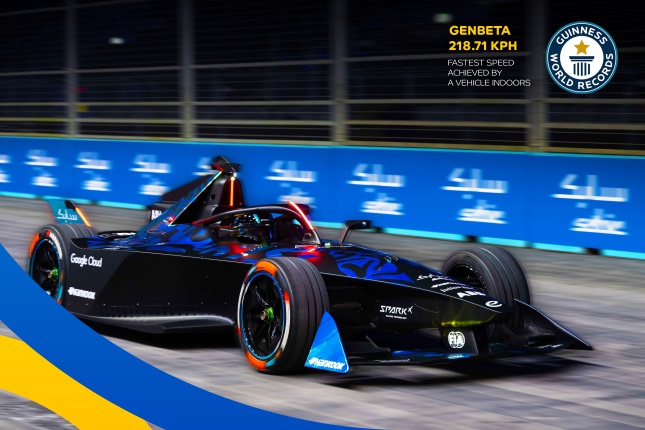NEW GENBETA CAR DEVELOPED BY FORMULA E AND ITS INNOVATION PARTNER SABIC SHATTERS GUINNESS WORLD RECORDS™ TITLE

- The GENBETA, a revolutionary electric race car developed in collaboration between Formula E, and its Innovation Partner SABIC, sets a new GUINNESS WORLD RECORDS™ title for the fastest speed achieved by a vehicle indoors by hitting a top speed of 218.71KPH
- SABIC is an integral partner in the GENBETA live development program that aims to advance new materials and technologies for future EV race and road cars
- SABIC’s involvement in GENBETA is driven by the company’s ambition to supporting the world shift towards electrification and carbon neutrality
- The GENBETA car is on display at the 2023 Hankook London E-Prix races, taking place between 29 and 30 July
SABIC, a global leader in diversified chemicals, formally highlighted the use of its materials in applications on the GENBETA car, the new holder of the GUINNESS WORLD RECORDS™ title for the fastest speed achieved by a vehicle indoors revealed and is now on display at the 2023 Hankook London E-Prix from today.
The GENBETA car was pushed to the limit by ABB FIA Formula E World championship drivers Jake Hughes (NEOM McLaren Formula E Team) and Lucas di Grassi (Mahindra Racing) in the Duals format used to qualify for Formula E races.
Jake Hughes hit a top speed of 218.71KPH, setting the new world record. The vehicle is part of the GENBETA live development and innovation project, which aims at exploring new materials and technologies for future EV race and road cars.
Leveraging application development expertise and material science, SABIC supported the design and development of innovative parts of the GENBETA car, which is based on the GEN3 car, helping and enabling the creation of the fastest, lightest, and most powerful and efficient electric car, reinforcing the company’s ambition to accelerating the world’s shift to electrification and carbon neutrality.
SABIC’s role in the GENBETA program and integration in the car forms part of the company’s collaborative innovation partnership with the world’s first all-electric FIA World Championship.
The materials from SABIC integrated into applications of the GENBETA car are highly engineered thermoplastics that enable design freedom through their inherent processing moldability compared to most other materials. Such thermoplastics can help enhance the car’s aerodynamics, contributing to its acceleration and speed performance.
The relevant applications include:
- Front wing endplates – These elements, formed using an additive manufacturing or 3D printing process known as fused deposition modeling, are mounted on the outboard extremities of the vehicle’s front wing. They are integral to redirection of airflow around the front wheels to help reduce drag while contributing to the car’s downforce and stability.
- Wheel fins – These components are manufactured through injection molding with SABIC’s sustainable mechanically-recycled thermoplastics from the portfolio of TRUCIRCLE™ circular materials. These parts are mounted onto the wheel rims in a radial, spoke-like pattern, and are intended to help optimize airflow and reduce aerodynamic drag for higher acceleration and speed performance. As an additional benefit, the fins can increase the car’s overall efficiency and aid in cooling the brakes to improve stopping power.
- Wind deflector – This transparent part is a coated thermoplastic sheet product, manufactured through an extrusion process using a bio-renewable, low-carbon material from the TRUCIRCLE portfolio. The component is attached to the front of the cockpit, ahead of the driver, and supports optimization of airflow for decreased drag – again, contributing to improved speed performance.




 Email: info@cyber-gear.com
Email: info@cyber-gear.com